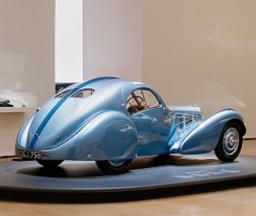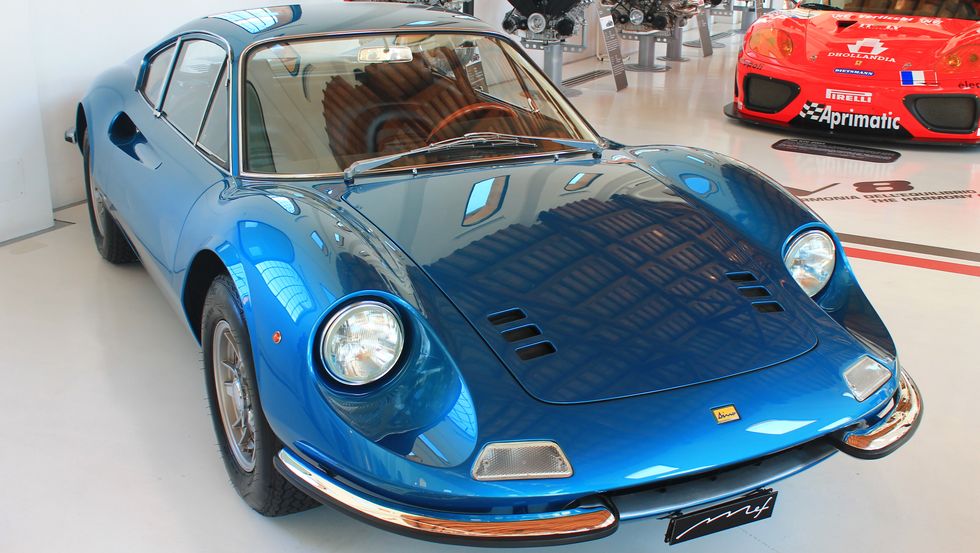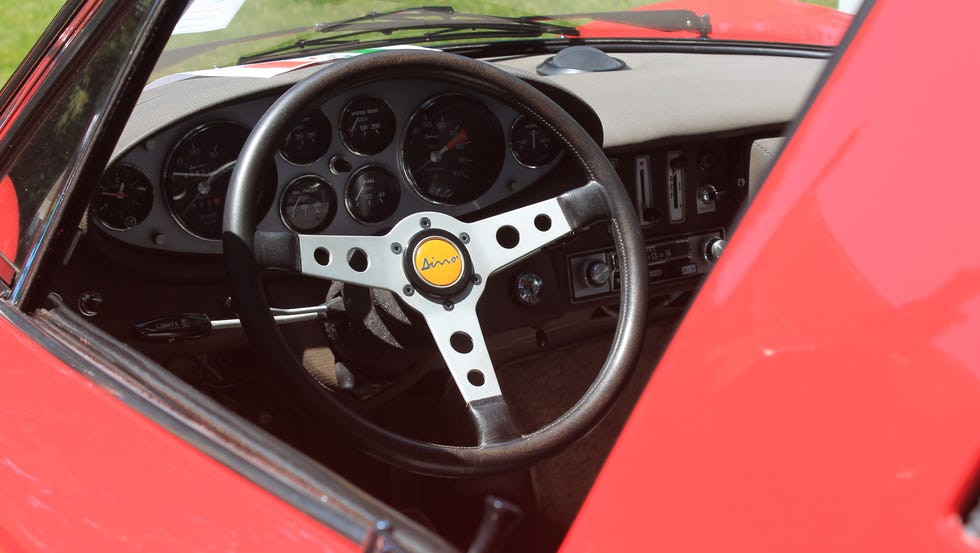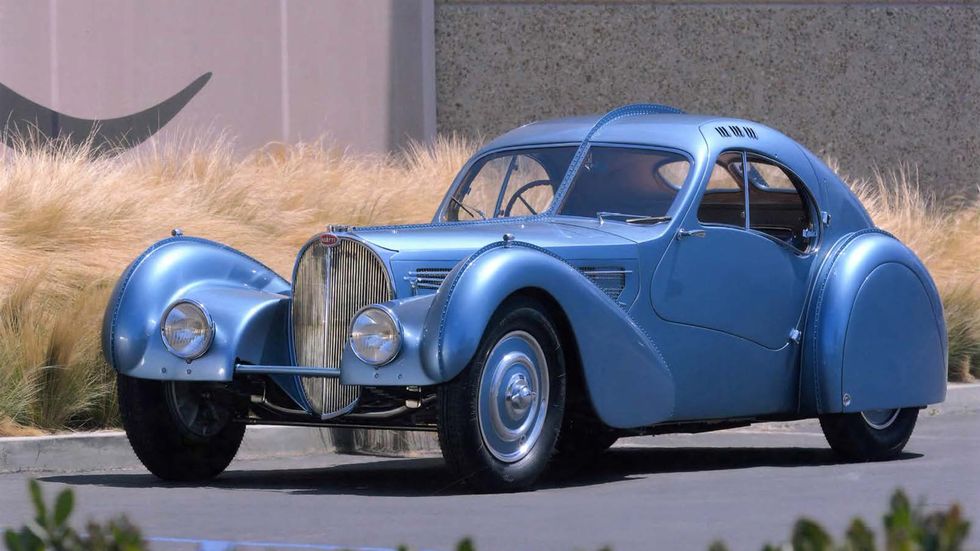The 10 Most Beautiful Cars According to Automotive Design Leaders
By: Gary Witzenburg (Car and Driver)

These stunning cars were deemed the most beautiful by more than 20 leading automotive designers.
These stunning cars were deemed the most beautiful by more than 20 leading automotive designers. The list varies from '60s classics to '70s supercars.

Bugatti
We recently asked a collection of 22 current and former design leaders in the automotive industry to share the 10 production cars they deem the most beautiful. While we expected differences between these leaders' lists, we were frankly stunned by the fact we received more than 100 nominations. Of those, 69 received just one vote, while another 20 earned two. That left 15 with three or more votes and 10 with four or more. These vehicles are listed below, as are the names of the 22 design pros who lent their expertise and opinion to our search for the 10 most beautiful cars ever produced.
10. Dino 206/246 GT (1967—1974)

Caleb Miller|Car and Driver
The Dino moniker honored Enzo Ferrari's late son, Alfredo "Dino" Ferrari, who was credited with designing the V-6 engine used in the vehicles bearing the Dino badge (its script is based on Alfredo's signature). Designed by Pininfarina, the 206 GT—a designation that referenced the 178-hp 2.0-liter V-6 powering it—was the first roadgoing Dino. A total of 152 206 GTs was built between 1967 and 1969 before the Dino 246 GT, with its 192-hp 2.4-liter V-6, succeeded it. After 1971, the 246 GTS offered a targa top.

Caleb Miller|Car and Driver
"Handsomely compressed sculpture with pure, low-hood, mid-engine proportions and purpose." —Kevin Hunter, president of Toyota's Calty Design Research
"Luscious form, exotic and intriguing, the Dino literally invented the iconography of a mid-engine sports car that still holds true today." —David Woodhouse, vice president of Nissan Design America
"With round, sculptural surfacing, mid-engine proportions, and distinct front-end design, this one always stands out." —Irina Zavatski, vice president of Chrysler Design
9. Lamborghini Countach (1974-1990)

Charlie Magee|Car and Driver
Hard to believe Lamborghini produced the wedgy mid-engine Countach for more than a decade and a half. Penned by Bertone's Marcello Gandini, who had previously styled the gorgeous Miura, the Countach first appeared in prototype form at the 1971 Geneva Motor Show. The supercar soon entered production powered by a 370-hp 3.9-liter V-12 after the prototype's design was fine-tuned to reduce aerodynamic drag, improve high-speed stability and engine cooling, and meet safety standards. It was further refined through succeeding model years, leading to the 449-hp 25th Anniversary Edition.

Lamborghini
"Its overall design and proportions were so unexpected and outstanding that it made other supercars of the era look like classic cars." —Anthony Lo, chief design officer at Ford Motor Company
"The simple and reduced wedge design is pure science fiction." —Domagoj Dukec, head of design at BMW
"A true show car that made it to production." —Henrik Fisker, founder, chairman, and chief executive officer of Fisker Inc.
8. Alfa Romeo 8C 2900B Lungo Spider (1937-1939, 1941)

Darin Schnabel/RM Sotheby's
Alfa Romeo's 8C 2900 was designed for racing, particularly the Mille Miglia. Based on the 8C 35 Grand Prix racing chassis, this mid-1930s Alfa used a 2.9-liter version of the company's straight-eight with two Roots-type superchargers fed by two Weber carburetors that afforded it an output of more than 200 horsepower. Its fully independent suspension used Dubonnet-type trailing arms, coil springs, and hydraulic dampers in front and swing axles with transverse leaf springs in back. Available with one of two wheelbases—the 110.2-inch Corto (short) and 118.1-inch Lungo (long)—the 8C 2900B began production in 1937 with its engine detuned to less than 200 horses and some concessions to comfort and reliability. 32 production 2900Bs were built in the late 1930s and one more was built from leftover parts in 1941. Most wore beautiful bodies by Carrozzeria Touring, though a few sported lines penned by Pininfarina.

RM Sotheby's
"This Alfa makes all others cringe when it rolls onto the lawn of any concours." —Ralph Gilles, head of design at Stellantis
7. Ferrari 250 GTO (1962-1964)

Richard Pardon|Car and Driver
Ferrari built three dozen 250 GTOs from 1962 to 1964, primarily for homologation (official acceptance) into FIA Group 3 Grand Touring Car competition. As enthusiasts know, 250 denotes the cubic-centimeter displacement of each of the racer's 12 cylinders, and "GTO" stands for Gran Turismo Omologato (Italian for "Grand Touring Homologated"). Of the 36 built, the first 33 wore 1962-1963 Series I bodies. The three 1964 models sported Series II (250 LM-like) skins. Four Series I cars were updated in 1964 with Series II bodies.

Bonhams
"The definition of a sexy, front-engine sports car." —Jeff Hammoud, head of design at Rivian
"Pioneering aerodynamics shaped this gorgeous car." —Robin Page, head of global design and UX at Volvo
"One of the most beautiful cars of all time." —Ralph Gilles, head of design at Stellantis
"Still the elegant high point in front-engine GT design." —Peter Brock, former designer, General Motors and Shelby America
6. Bugatti Type 57 S/SC Atlantic Coupe (1936-1938)

Bugatti
A total of 710 Bugatti Type 57 touring cars were produced from 1934 through 1940, each powered by the 135-hp 3.3-liter twin-cam straight-eight from the automaker's Type 59 Grand Prix cars. These machines wore a smaller version of the Royale's square-bottom horseshoe grille, and the sides of their engine covers sported thermostatically controlled cooling shutters. The two basic variants were the original Type 57 and the lowered Type 57 S/SC—"S" for Surbaisse (lowered) and "C" for Compresseur (supercharger). Just 43 S cars and two supercharged SCs were originally built, but some S owners returned their cars to Molsheim for installation of superchargers, which boosted the engine's output from approximately 175 horsepower to around 200 horsepower. Bugatti built a total of four Atlantics: three for customers and one kept by Jean Bugatti, son of the automaker's founder, Ettore. While the three customer cars are accounted for, the whereabouts of Jean's Atlantic remains a mystery.

Peninsula Classics Best of the Best
"Super elegant, yet ingenious." —Klaus Zyciora, head of design at Volkswagen Group
"A dramatic combination of curves and undulating proportions." —Ian Cartabiano, vice president of advanced design at Toyota
5. Mercedes-Benz 300SL (1954-1957)

Brian Henniker courtesy of Gooding & Company
Based on Mercedes-Benz's 1952 W194 racer, the 300SL was produced as a gullwing-door coupe from 1954 to 1957, then as a roadster from 1957 to 1963. Powered by a 240-hp 3.0-liter inline-six with mechanical direct fuel injection, the 300SL was the fastest production car of its time. U.S. importer Max Hoffman convinced Mercedes management to build this amazing car and unveiled it in New York City (instead of in Europe) in 1954 to get it into U.S. buyers' minds and hands sooner. The SL stood for "super-light" ( superleicht in German), referring to its race-bred tube-frame construction. M-B built 1400 300SL coupes before switching to roadster production in 1957.

"Almost the perfect balance of elements, including the turret-top cabin. Sleek without being curvy, powerful without being brutal." —Ian Cartabiano, vice president of advanced design at Toyota
"Most elegant German sports car." —SangYup Lee, head of Hyundai's Global Design Center
"Beautifully engineered gullwing doors make this a legend." —Robin Page, head of global design and UX at Volvo
"Still looks amazing after nearly 70 years." —Irina Zavatski, vice president of Chrysler Design
4. Porsche 911 (1964-Present)

Andi Hedrick|Car and Driver
When the 911 debuted in 1964, it was a major improvement over Porsche's lovable but homely 356 coupe and convertible. But few back then would have called it beautiful. Yet our expert panel contends it has earned that descriptor through 58 years and counting of brilliant evolution of the same basic look. We've often marveled at how challenging it must be for the 911's lead designer at any given time to make its next iteration new and fresh—yet essentially the same—with every generation. But Porsche designers continue to overcome that challenge.

Andi Hedrick|Car and Driver
"Perfect sculpture and surfacing. The ultimate example of design perfection." —Henrik Fisker, founder, chairman, and chief executive officer of Fisker Inc.
"Redesigning an icon is no easy feat." —Karim Habib, head of design at Kia
"Its designers have continually honed this theme and made it into one of the most iconic designs of all time." —Ralph Gilles, head of design at Stellantis
3. Chevrolet Corvette Sting Ray Split-Window Coupe (1963)

Chevrolet
The second-generation Corvette stunned the public when it appeared—seemingly from outer space—in 1963. One of our panelists who worked on the car's conception shared that "three or four of us were there when [soon-to-be GM styling VP William L. Mitchell] walked in." Peter Brock was then one of four young designers in a remote basement research studio.
"He pulled out a bunch of pictures from [the Turin Auto Show], and they all had a crisp line around the belt separating upper from lower and aerodynamic shapes over the wheels. And the one that really got to him, even though it was two years old by then, was the Alfa Romeo Disco Volante. Alfa had done roadster and coupe versions, and Mitchell wanted to do the first Corvette coupe."
Brock's theme won the resulting competition and led to Mitchell's gorgeous Corvette Stingray race car of the late 1950s, which was ultimately refined into the '63 Corvette by Larry Shinoda and Tony Lapin in Mitchell's super-secret Studio X.

Barrett-Jackson|Getty Images
"Most beautiful Corvette designed. Great combination of sculpture and sharp lines." —Jeff Hammoud, head of design at Rivian
"It carries an incredible sense of motion with its Mako Shark-inspired body, hidden headlamps, and iconic split window." —Ralph Gilles, head of design at Stellantis
2. Lamborghini Miura P400/P400S (1967-1971)

RM Sotheby's
The mid-engine Lamborghini Miura P400 shocked the world when it reached production in the late 1960s. Powered by Lambo's 345-hp 3.9-liter V-12, the Miura was the world's fastest road car and lived through 1973 with periodic updates despite its then-steep (initial) price of $20,000. Lambo built exactly 275 P400s through 1969, and it produced the slightly revised P400S (338 built) between 1968 and 1971.

RM Sotheby's
"The P400 Miura stunned the world as the most innovative and spectacular supercar ever seen." —Peter Brock, former designer, General Motors and Shelby America
"I am still in awe of its hood and shoulder line that blends into the upper door and frames the scoops adjacent to the side windows." —Ralph Gilles, head of design at Stellantis
"Gorgeous proportion, as if the body was shrink-wrapped around the mechanicals." —Anthony Lo, chief design officer at Ford Motor Company
"Taut and restrained athletic elegance." —Kevin Hunter, president of Toyota's Calty Design Research
"It always stops me in my tracks." —Irina Zavatski, Vice President of Chrysler Design1. Jaguar E-type Coupe (1961-1967)
1. Jaguar E-type Coupe (1961–1967)

S joerd van der Wal|Getty Images
Enzo Ferrari is rumored to have called the Jaguar E-type "the most beautiful car ever made." Our panel of designers shared il Commendatore 's feeling, as the 1961-1967 E-type coupe takes the top spot in this 10-car list.
Jaguar's E-type hit the streets in 1961 with a blend of jaw-dropping beauty and strong performance that immediately established it as a sports-car icon. Its 265-hp 3.8-liter (later 4.2-liter) inline-six, relatively light weight, claimed 150-mph top speed, four-wheel disc brakes, rack-and-pinion steering, and independent front and rear suspension—all at a fairly reasonable price—elevated it well above wannabe competitors.
Most agree that the roadster was almost as lovely, but the 2+2 that arrived in 1966 . . . not so much. Series 1 E-type coupe production totaled 13,500 before the slightly altered Series 1.5 E-type arrived for 1968.

Sjoerd van der Wal|Getty Images
"Long, low, sensual. Still looks amazing." —Ian Cartabiano, vice president of advanced design at Toyota
"Romantic proportions, elegant, timeless, forever the most beautiful." —Michelle Christensen, vice president of global design at Honda
"Delectable. Delicious. Sublime! Universally appealing sculpture on wheels. Drop-dead gorgeous!" —David Woodhouse, vice president of Nissan Design America
Meet the Panelists

- Peter Brock, former designer, GM and Shelby America
- Ian Cartabiano, vice president of advanced design at Toyota
- Wayne Cherry, former vice president of global design at GM
- Michelle Christensen, vice president of global design at Honda
- Domagoj Dukec, head of design at BMW
- Henrik Fisker, founder, chairman, and CEO of Fisker Inc.
- Ralph Gilles, head of design at Stellantis
- Karim Habib, head of design at Kia
- Jeff Hammoud, head of design at Rivian
- Kevin Hunter, president of Toyota's Calty Design Research
- Jon Ikeda, vice president and brand officer of Acura
- SangYup Lee, head of Hyundai's Global Design Center
- Anthony Lo, chief design officer at Ford Motor Company
- Dave Marek, executive creative director of Acura
- Robin Page, head of global design and UX at Volvo
- Michael Simcoe, vice president of global design at GM
- Yasutake Tsuchida, senior director of design at Mazda
- Gorden Wagener, chief design officer at Mercedes
- Ed Welburn, former vice president of global design at GM
- David Woodhouse, vice president of Nissan Design America
- Irina Zavatski, vice president of Chrysler Design
- Klaus Zyciora, head of design at Volkswagen Group
No politics, no religion, no instagrams, and commentary must be civil. The ToS and the CoC will be enforced, and anything that the administrator deems to be offensive will be deleted. YouTubes, videos and images that the administrator is unable to open must be described and explained or they will be deleted.








Personally, I prefer the slightly older Corvette to the one the panel picked. Just because I've got a protruding nose doesn't mean I would like a car with one.
And as well, I never liked the looks of the Jaguar E-type. Back in 1959 I fell in love with the classic style of the 1959 Jaguar Mark IX and my feelings about it haven't changed.
As well, I like this model of Lincoln Continental.
I know that someone here likes the Delahaye.
What would YOU choose as a beautiful classic car?
I have to agree with you, always preferred the 57 Vette over the later ones.
Glad to have your agreement about that.
Guilty as charged…
Yes, it was you who I meant.
Beautiful
And
LOL. I don't know if you mean the Avanti is beautiful or ugly. At least it's unique. Now a lot of cars don't have a grill because their electric motors must not need cooling.
Loewy
Don't be shy, say it. Raymond Loewy designed the Studebaker Avanti. This is another car he designed.
A Loewy bus....
A Loewy train?
I’m baffled. Any list like this that doesn’t have the Delahaye 135 on it - much less at Number 1 - is just wrong.
This could easily be remedied by removing the Countach from the list. As we see from the Miura at Number 2, it’s not even the prettiest Lamborghini. The Countach is iconic, to be sure, but IMO because it’s odd, not because it’s beautifully designed.
Might as well throw out an Honorable Mention to my personal 69 Corvette 427 with the factory side exhaust. Sadly, I sold this years ago.
The fact that 20 top car designers passed the Delahaye up is just another reason whey I don't agree with all their choices. They're all mired into the standard of the cars they themselves design. I guess Snuffy and I feel the same way about Corvettes, but naturally we're not all identical robots. I like a lot of older cars, and sure as hell prefer them to the clamshell or turtle design the panel designers favour.
Today's cars are determined by aerodynamics. Not long ago, a cD of 0.35 was acceptable. Now we're getting close to 0.2. That homogenizes styling, but breathing is good.
Come Spring 2025, we'll buy one of these:
I like the styling... but it's not gonna sweep anyone off their feet.
Style, aerodynamics, packaging...
I like cars.
To me leaving off the Delahaye is a crime, it’s like leaving the Mona Lisa off of a list of great paintings.
It could even be the 8th deadly sin.
I like being able to see the wheels and tires on cars
That kind of leaves the Delahaye out of it. LOL
Had a former brother in law back in the early 70's who bought a mint condition lemon yellow 63 Corvette with the split rear windows. For some odd reason that I still cannot fathom to this day, he decided to convert to a cosmetic 68 model with the side vents and whole rear window. Swapped the stock 63 engine for a 427 cubic inch V8 with a Holley Quad carb.repainted it a god awful metallic avocado green color. People tried to warn him that he was committing sacrilege by screwing up already nearly perfect Corvette! He would not listen. The car was a monster on the road to drive. It was fast, but only got about 8 miles a gallon. He eventually sold it about four years later because he could not afford to drive it. I still laugh about that along with my sister who told him he really messed up.
I only knew one person in my life who was into classic cars, one of my best friends and classmates who would only drive classic Mustangs, called it his "mouse" (it was before computers were happening).
The 63 vette is another all time classic.